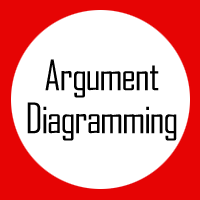http://oli.cmu.edu/courses/free-open/argument-diagramming-course-details/
Alexandra Drozd, Carnegie Mellon University, Department of Philosophy
Maralee Harrell, Carnegie Mellon University, Department of Philosophy
Argument Diagramming course at the Open Learning Initiative, Carnegie Mellon University
The Argument Diagramming course at the Open Learning Initiative at Carnegie Mellon University helps students take charge of their own thinking, and learning, by introducing or reintroducing them to fundamental critical thinking skills that are useful across courses, majors, and areas of life. Argument Diagramming, is a method of argument analysis using diagrammatic representations.
This material exemplifies connected learning principles because this method of analysis and these ways of thinking can be used across domains and interests, with peers and with colleagues, anywhere from the ultimate Frisbee field to the computer lab to the cafeteria. The Argument Diagramming course focuses on crucial 21st century cognitive competencies; for example, the determining the premise and conclusion of an argument is essential to the Cognitive Processes and Strategies of Critical thinking, Analysis and Reasoning/Argumentation.
We have incorporated openly-available digital Argument Diagramming software, iLogos, into the OLI’s online activity platform, which enables us to collect data about every interaction of every student, with our online course. The data collected informs continued development and redevelopment efforts, as the course is improved to further explicate the objectives and concepts about which students may harbor misconceptions or have remaining questions. Since 2009 we have reorganized the course to better support a “Big Picture” view of the material and provide more effective connections to existing student knowledge.
The Argument Diagramming course unifies student interaction with researcher analysis through persistent collaboration, and adapting through research on this data, to student needs and practices.
The OLI course Argument Diagramming, in existence since 2006 and used by participants at multiple institutions nationwide, exemplifies open learning in a number of ways. As indicated by CC-By ND status and availability Open + Free at http://oli.cmu.edu/courses/free-open/argument-diagramming-course-details/, it is an “open educational resource”. Also relevant is the course’s “data openness”. The anonymized data collected from the OLI course is openly available so that researchers and learning engineers the world over may learn from this data.
Argument Diagramming appeals to a wide variety of learners, with argument examples on subjects from gun control to poor academic performance as well as a wide variety of activities so learners may practice outcomes in many different ways prior to assessment.
Students drive development of the OLI Argument Diagramming course, from graduate students who led its creation to data continually gathered from student participants that shapes further developments of the course. Key features of this course have emerged from student ideas and in response to student data, including platform integration of the iLogos software, presentation of a high-level Big Picture of Argument Diagramming and the expansion of sections on arguments contained within single sentences and words that frequently indicate parts of arguments.
We incorporate digital resources and practices by providing digital images of all argument diagrams used in the course, integrated digital argument diagramming software to complete activities in the course, and freely available Argument Diagramming software for continued use following the completion of the course.
As we continually collect data, we continually have areas that can be improved. We hope to expand the course to specifically address certain “learning contingencies” revealed in a study of F2012 data. In the current version of the course there are certain questions that nearly perfectly predict performance on exam questions. These are cases where we would like to examine performance on all activities related to a certain learning outcomes and create additional activities where students can achieve said outcomes.
Tags: Open Education Resource
Posted in Gallery |
